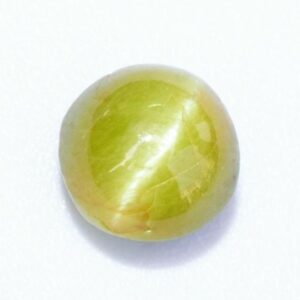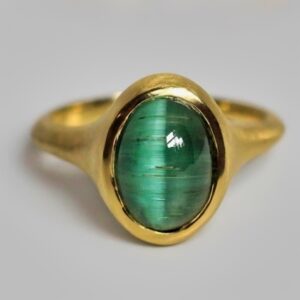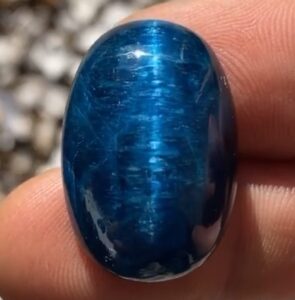Rocks and gemstones with a cat’s eye effect, also known as Chatoyance, are beautiful and unique stones that display a fascinating visual effect. They have an iridescent, twinkling quality that resembles a cat’s eyes or silk’s shimmer.
When light shines on the surface of a chatoyance rock, the surface can appear to move like liquid or reflect the light in a rainbow of colors. The tiny fibrous inclusions within the stone cause this rare effect. These stunning rocks will surely add a hint of mystique and beauty to any collection.
For an idea of what this looks like, here are four examples of the cat’s eye effect!

Cat’s Eye Chrysoberyl
Cat’s Eye Chrysoberyl is a stunning gemstone that exhibits a phenomenon called chatoyance, or “cat’s eye.” This gemstone is composed of a mineral called beryllium aluminum oxide. It has a unique optical effect that causes it to appear to shimmer and glow when viewed from different angles.
Its chatoyant effect is due to tiny needle-like inclusions of rutile that reflect light in a single line across the stone’s surface. Cat’s Eye Chrysoberyl is highly valued for its beauty and rarity and can be found in jewelry and gemstone collections.
*** Need help identifying chrysoberyl?
Properties:
- Mohs Hardness: 8.5
- Specific gravity: 3.5 – 3.84
- Refractive index: 1.74 – 1.75
Uses:
- Jewelry

Cat’s Eye Tourmaline
Cats Eye Tourmaline, when polished, exhibits a remarkable cat’s eye effect thanks to its tiny parallel inclusions. Usually crafted in a cabochon shape, these gems come in a rainbow of colors and range from semi-translucent to opaque.
The cat’s eye should have a noticeable eye effect, with a bold white line running through it. The price of the stones varies, based on their size, color, how translucent they are, and sharpness.
Properties:
- Mohs Hardness: 7.0 – 7.5
- Specific gravity: 3.08
- Refractive index: 1.62 – 1.64
Uses:
- Jewelry

Cat’s Eye Alexandrite
Cat’s Eye Alexandrite is a rare and exotic gemstone and displays a remarkable transformation of color depending on the type of light it is exposed to. Under the sun or bright fluorescent light, this gemstone has a lovely medium-green to bluish-green look. When illuminated with incandescent light, however, its beauty truly radiates in the stunning violet-red hue it exudes.
This remarkable gemstone is highly sought after by collectors and those looking for a unique and beautiful piece of jewelry.
Properties:
- Mohs Hardness: 8.5
- Specific gravity: 3.5 – 3.8
- Refractive index: 1.74 – 1.76
- Durability: Tough
- Location: Brazil, Sri Lanka, and Russia
Uses:
- Rare and unique jewelry

Cat’s Eye Apatite
Cat’s Eye Apatite is unique, with its mesmerizing chatoyance, or ‘cat’s eye’ effect. This effect is a reflection of light off of the fibrous inclusions within the stone. It’s enthralling and stands out from the rest of the apatites due to its special ‘cat’s eye.’
Its color is a captivating mix of greenish-yellow to bluish-green hues, giving it an almost ethereal quality. This gemstone is a member of the apatite mineral family and is sure to make an impression with its captivating appearance.
Cat’s Eye Apatite is a popular gemstone among collectors and jewelers alike. Its prices can range from a few hundred dollars to thousands of dollars depending on the size and quality of the gemstone. When shopping for Cat’s Eye Apatite, remember that the larger and brighter the chatoyance, the higher the price.
Properties:
- Mohs Hardness: 5.0
- Specific gravity: 1.63 – 1.64
- Refractive index: 3.2
- Location: Madagascar and Brazil
Uses:
- Jewelry making
Common and Rare Chatoyant Rocks (Cat’s Eye Effect)
Rocks and gemstones displaying chatoyance are fascinating and can only be found in a handful of locations. While some are more common than others, all are unique and have distinct properties. Knowing the different types can help you to explore them even further.
Whether you are a hobbyist or a professional, studying these rocks and minerals can be a great way to expand your knowledge and collection of rocks and gemstones with a cat’s eye effect.
- Identify Enstatite - March 12, 2024
- Identify Cerussite - March 3, 2024
- Identify Bytownite - February 18, 2024
